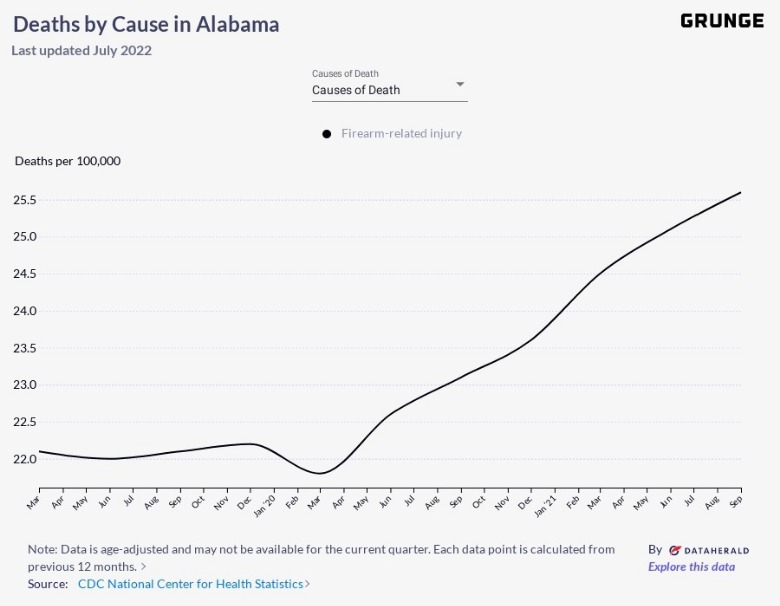Here's Proof That Alabama Has A Big Problem With Shooting Deaths
Gun-related deaths in the U.S. are on the rise since the onset of the COVID-19 pandemic in 2020, according to CDC data (via CNBC). Moreover, the problem seems to affect people of every age and of every race in both cities and in rural areas. High-profile mass shootings, such as in Uvalde, Texas at Robb Elementary when 19 schoolchildren and two adults were shot and killed before authorities shot and killed the gunman, have sparked heated debate over how best to address the issue (per The New York Times). Among other examples of the worsening gun death problem in America, in response to the Uvalde school shooting, for example, the U.S. House of Representatives passed the toughest assault weapons ban since the '90s, as MSNBC reports.
Since most gun-related mortality comes from suicide instead of homicide, what perplexes experts about pandemic-era gun violence is that while suicide rates are steady, homicide rates have gone up. As previously mentioned, that unprecedented uptick in U.S. gun violence is everywhere, maybe nowhere more so, though, than in Alabama, where beginning in March 2020, CDC data (below) reflects a sharp spike in gun deaths per capita. The root causes of gun violence are hard to identify, and many factors likely influence the issue. A look at several key demographic and statistical factors in this southern state, though, may help explain how and why Alabama has been so hard hit.
If you or anyone you know is having suicidal thoughts, please call the National Suicide Prevention Lifeline by dialing 988 or by calling 1-800-273-TALK (8255).
Gun deaths in Alabama are on the rise
At the outset of 2020, the rate of gun-related mortality in Alabama hovered at around 22 deaths per 100,000 residents. After dipping somewhat at the onset of the pandemic, the number of gun deaths in Alabama has only increased, much as it has everywhere else in the U.S. There are few firm definitions of what constitutes a mass shooting, though they're often defined as one shooting incident in which four or more people are killed (via The Marshall Project). What makes Alabama's numbers more confounding, then, is that there are relatively few mass shootings in the Cotton State, according to AL.com. The rates of mass shootings in the U.S., however, rank among the worst per million residents compared to other developed nations, as World Population Review also notes.
Nowhere in the U.S. is completely immune to the post-pandemic gun violence issue, but according to CNBC, Black Americans are more affected by gun violence with a 40% increase in gun-related homicide during the pandemic, or roughly 12 times higher than that of white Americans. As CNBC goes on to note, poverty also plays a part and the most impoverished counties in the U.S. typically show rates of firearm murder and suicide up to 4.5% higher than average. Accordingly, the state of Alabama is the fifth poorest state in the U.S., with some 17% of state residents living in poverty (via Alabama Possible).

